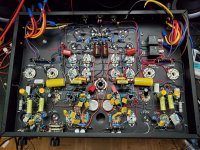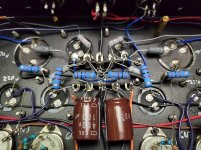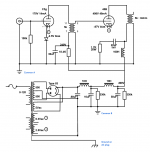I am going to build a 30watt, PP, 12BH7A/6L6GC amp from the book "Vacuum Tube Amplifier Basics" by EJ Zurich. This design is a mono block, but I'm converting it to stereo. My only concern is the grounding scheme. The author uses many 3 & 5 lug solder terminals, which is fine from a neatness standpoint. However, all grounds, both power and signal, are strictly through the ground lugs on these terminals. There is no starpoint. I've read that ground wires provide a much better return path than the chassis alone. Is this something I should be concerned about?
Yes, never use the chassis for an audio ground (actually the term should be "common").
This was done decades ago, and is still done in some guitar amps, but we know better now.
There should be only one connection from the audio common to the chassis, and sometimes
this is made with a low value resistor, diodes, a capacitor, or some combination of these.
Don't use more than one center lug total on the terminal strips for grounding, or this will cause
the same problem as grounding to the chassis at multiple points. Return all the local commons
to the single main audio ground (common) point.
http://hifisonix.com/wordpress/wp-content/uploads/2019/02/Ground-Loops.pdf
This was done decades ago, and is still done in some guitar amps, but we know better now.
There should be only one connection from the audio common to the chassis, and sometimes
this is made with a low value resistor, diodes, a capacitor, or some combination of these.
Don't use more than one center lug total on the terminal strips for grounding, or this will cause
the same problem as grounding to the chassis at multiple points. Return all the local commons
to the single main audio ground (common) point.
http://hifisonix.com/wordpress/wp-content/uploads/2019/02/Ground-Loops.pdf
Last edited:
The problem is if connecting all the returns through one wire you are sending large amounts of noise etc from the heavy current drawing output devices down the same way as the sensitive input earth returns.
JLH separated input and output via a 10ohm resistor after the VAS, all earth returns before that went via the input earth ,all earth returns after that went via the output power earth.
JLH separated input and output via a 10ohm resistor after the VAS, all earth returns before that went via the input earth ,all earth returns after that went via the output power earth.
For those 3 and 5 lug terminal strips, you can use the #4-40 insulating shoulder washer that you would get with a TO-220 heatsink mounting kit plus a plastic acorn nut to isolate these terminals from the chassis. With those terminals isolated from the chassis, you can then use wire to create a ground buss to your liking.
I'd use a larger strip that is securely bolted to the chassis (with no insulator), and cannot move around.
There are terminal strips with no solder lug on the mounting terminal, or else on a regular one you can
bend it down or cut it off.
https://i0.wp.com/www.dynakitparts.com/wp-content/uploads/90-D.jpg?fit=800,600&ssl=1
There are terminal strips with no solder lug on the mounting terminal, or else on a regular one you can
bend it down or cut it off.
https://i0.wp.com/www.dynakitparts.com/wp-content/uploads/90-D.jpg?fit=800,600&ssl=1
Last edited:
I agree with page 37 marked --Right ! but John includes up to the VAS stage in the input earth return ,page 40 isn't showing full detail only the standard shape of an "amplifier box " with a single earth return John goes deeper into it defining the separation.
I use chassis as common ground all the time. I ground the audio where the tube cathode and grid leak is grounded, and I use one common ground point for the PSU caps. YMMV but it works fine for me. I hear nothing with my ear to the speaker )hum/hiss/RF/noise etc).
Here's one I was building today...
If you use the chassis for AC heater return you WILL get hum in the audio though. Any high current loads like power tube heaters should be returned with the power using twisted leads, but you probably knew that. In the case of this one, the chassis is grounded, the tubes on the left side are connected with the ones on the right side in series using 12V DC. All of the heaters together add up to almost a 10A load!
Here's one I was building today...
If you use the chassis for AC heater return you WILL get hum in the audio though. Any high current loads like power tube heaters should be returned with the power using twisted leads, but you probably knew that. In the case of this one, the chassis is grounded, the tubes on the left side are connected with the ones on the right side in series using 12V DC. All of the heaters together add up to almost a 10A load!
Attachments
Last edited:
The most important thing is to keep the rectifier currents and speaker currents out of your sensitive signal ground return paths. This means returning the ground main power supply cap (before the choke) straight back to the transformer and to the speakers usually. Using a star ground enforces the rule but there are other ways. Building an amp as chassis as ground is not a problem (and is safe) as long as you still do the rules, but if you do the same for your pre-amp - you run the risk of a ground loop through the mains wiring. As for heaters balanced is best.
Last edited:
I have encountered that. One power supply for a pre amp and power amp in two different boxes. Connecting the pre to the power amp passed on switching hash etc, and I needed to use audio isolation transformers between them. Everything I've built with it's own PSU worked as expected though.
Thankfully, most tube amps don't have speaker current returning through the chassis, just the gNFB loop if there is one so that's usually not a concern.
Thankfully, most tube amps don't have speaker current returning through the chassis, just the gNFB loop if there is one so that's usually not a concern.
...and I fell into the differential hum loop issue. It may be very nice having separate L and R channels spaced far apart - but actually its much better for the first stage to have its inputs close together even a dual triode - so the ground for L and R inputs is taken from the same point. Fortunately there's good advise on the forum. The url in #2 Rayma posted is excellent.
If you do use separate grounds and join with a resistor to chassis (say 10R) make sure from a safety point of view it has a rating enough to withstand the max HT current. If the HT shorts to chassis and the resistor goes o/c then all your inputs become -HT!
If you do use separate grounds and join with a resistor to chassis (say 10R) make sure from a safety point of view it has a rating enough to withstand the max HT current. If the HT shorts to chassis and the resistor goes o/c then all your inputs become -HT!
Last edited:
Please see attached schematic and let me know if I have my grounding correct.
My plan is as follows:
1. "Common A" for the signal related parts
2. "Common B" for the power supply parts
3. "Common A", "Common B" and power transformer center tap will tie together at the ground on the IEC inlet.
Comments?
Thanks,
Pat
My plan is as follows:
1. "Common A" for the signal related parts
2. "Common B" for the power supply parts
3. "Common A", "Common B" and power transformer center tap will tie together at the ground on the IEC inlet.
Comments?
Thanks,
Pat
Attachments
The IEC ground should be attached to the chassis close to the connector by itself , bonded mechanically, not soldered. Since you're not trying to get safety certified to resale, you can do as you please though.
The IEC ground should be attached to the chassis close to the connector by itself , bonded mechanically, not soldered. Since you're not trying to get safety certified to resale, you can do as you please though.
Thats a point , decades ago (1984) JLH,s 80W mosfet power amp design went public ,up until then John made a point that mains induced distortion/noise played a big part in reproduction quality so he showed no earths in articles in his circuits in EW.
This couldn't stand when actual units bearing his name (as designer ) were sold in the UK by a third party .
He then had to advise that an earth was needed for UK regulations at the time but his observations in EW on RF/noise/hash /etc are still relevant particularly in urban areas and cities.
- Home
- Amplifiers
- Tubes / Valves
- Grounding


